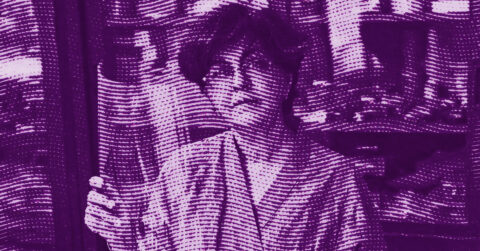Listen to me carefully, you bunch of snobs! You have surely heard of Njideka Akunyili Crosby, this Nigerian-American artist who has the contemporary art world at her feet, with her MacArthur Genius Grant and auction sales reaching stratospheric prices. But how many of you have really looked at her work? I’m not talking about casting a distracted glance before moving on to the next Instagram sensation. No, I mean stopping, breathing, and immersing yourself in her dizzying visual worlds. Akunyili Crosby’s paintings don’t jump in your face with the kind of easy brilliance that dominates our era of fragmented attention. They rather invite you to come closer, lean in, and get lost in their meticulously constructed depths.
Akunyili Crosby’s work operates in a liminal space, between Nigeria and America, between memory and the present, between the intimate and the collective. Each piece is a challenge to our simplistic understanding of cultural identity. Take “Still You Bloom in This Land of No Gardens” (2021), a work capturing the artist with her child, surrounded by lush vegetation partially obscuring their bodies. The way plants intertwine with the figures recalls anthropologist Claude Lévi-Strauss and his concept of “wild thought” [1].
Lévi-Strauss argued that cultural systems are like bricolages, creative assemblages made up of diverse elements from different sources. Isn’t that exactly what Akunyili Crosby does? She juxtaposes visual references from Nigeria and the United States, creating a personal taxonomy where rigid classification gives way to a more fluid associative intelligence. In her works, everyday objects, a sofa, a teapot, a table, become totems charged with cultural meaning, much like how Lévi-Strauss viewed “wild” objects as bearers of complex significations that defy Western categorizations.
This artist uses banal objects as vehicles of collective memory, creating what Lévi-Strauss would call a “system of signs” to navigate between cultures. The enamel teapot on the table in “Tea Time in New Haven, Enugu” is not just a decorative accessory; it is a cultural artifact that speaks of British colonial heritage in Nigeria, reappropriated and transformed into something specifically Nigerian. This is precisely the kind of “cultural bricolage” that Lévi-Strauss identified as being at the heart of creating hybrid cultural identities.
But what truly distinguishes Akunyili Crosby is her photographic transfer technique. She applies solvents to the backs of images taken from Nigerian magazines and books, sealing these images onto the painting’s surface. This method creates meticulous visual hallucinations, layering memories over moments that fully live in the present. And this is where we see the influence of Gaston Bachelard and his “Poetics of Space” [2].
Bachelard taught us that intimate spaces, houses, drawers, corners, are containers of memory and imagination. He wrote: “The house is our corner of the world… it is our first universe, a true cosmos.” Akunyili Crosby’s domestic interiors function exactly like these Bachelardian spaces. In “The Beautyful Ones” Series #11, we see a young girl in a white communion dress standing in an interior space lined with transferred images. It is not merely a portrait; it is what Bachelard would call a “topography of our intimate being.”
The meticulous attention that Akunyili Crosby pays to details of domestic interiors, the floor patterns, commemorative fabrics on the walls, objects on tables, is not simply decorative. She creates what Bachelard would call a “poetics of dwelling.” In “Mama, Mummy and Mamma,” three generations of women are represented in a domestic space filled with memories, a visual manifestation of what Bachelard calls “the oneiric house,” a space that transcends the physical to become a reservoir of dreams and memories.
The windows, doors, and frames that appear so frequently in Akunyili Crosby’s work function as Bachelardian “thresholds,” points of passage between different states of being. In “Portals” (2016), the artist literally creates what Bachelard would call a “dialectic of inside and outside,” using architectural structures as metaphors for the transition between worlds. These portals are not simply architectural elements; they are passages between Nigeria and America, between the past and the present.
The ultra-flatness of her images creates a profound calm, as if they exist outside the normal flow of time. This unique temporality is what Bachelard would call a “verticality” of time, where past, present, and future compress into a single moment. In these works, time is not linear but vertical, allowing different eras and places to coexist in a single pictorial space.
The presence of plants in her recent works adds another layer of contemplation, creating a sliding between interior and exterior space, foreground and background, self and environment. In these scenes, rendered on paper and fixed to the wall with binder clips and nails, the painted and photographed figures are integrated into lush worlds of foliage, blurring (and sometimes completely tearing apart) the distinctions between humans and biotic forms.
This merging of human bodies with their environment recalls Bachelard’s concern with how intimate spaces shape our being. Akunyili Crosby extends this idea by suggesting that our identity is inextricably linked not only to the spaces we inhabit but also to the natural and cultural ecologies surrounding us. The plants blooming throughout this most recent body of work introduce yet another layer of reflection, causing a sliding between interior and exterior space, foreground and background, self and environment.
Akunyili Crosby’s work also evokes Bachelard’s notion of “resonance,” the way objects and spaces can evoke memories and emotions that resonate within us. The transferred images that appear on clothing, walls, and furniture in her paintings literally create this visual resonance, weaving together fragments of cultural memory to form a complex visual symphony.
Akunyili Crosby’s work is deeply autobiographical but never solipsistic. She uses her own experience as a starting point to explore broader issues of migration, identity, and cultural memory. As she herself has said: “I paint Nigeria as it was when I left at the end of the ’90s, which is not the same as Nigerian culture now… It is my life, my autobiography, my family, but these cultural, economic, and geographical experiences speak of something larger than me: they are a confluence of disparate things.” [3]
What is particularly striking in her work is the way she avoids the traps of easy nostalgia. There is a brutality hidden in beauty. “A Sunny Day on Bar Beach” depicts a public beach in Lagos where the former military government executed people. This juxtaposition of the domestic and the political recalls how Lévi-Strauss saw cultural structures as intrinsically linked to power structures. The military dictators who betrayed Africa’s promise appear fleetingly in her photographic transfers, reminding us that cultural memory is always entwined with political history.
In “Blend in, Stand out,” a woman embraces a seated man from behind, a black person and a white person, Akunyili Crosby and her husband. In the center of the image is an Igbo pot. Her dress is green and filled with images of black figures with raised fists. “I think about this bank of memory that I have carried since growing up in Nigeria,” said Akunyili Crosby. Look closely and you will see this reservoir of images integrated everywhere in her art: in the clothing, in the wallpaper, surfaces of thought and feeling.
Akunyili Crosby’s work resists simplification and easy categorizations. She invites us to consider how identities are formed at the crossroads of multiple cultural influences, how memory persists through objects and spaces, and how art can create a “third space” where different realities can coexist. As Lévi-Strauss would remind us, cultural identities are never pure or static but always in a process of “bricolage,” assembled from diverse elements to create something new and unique.
Akunyili Crosby’s works are not simply representations of spaces; they are spaces in themselves, places where we can momentarily enter and inhabit, places that resonate with our own lived experience. In a world obsessed with fixed identities and rigid boundaries, Akunyili Crosby offers us a more fluid and generous vision of what it means to exist between worlds.
The next time you have the opportunity to see her work, do not be one of those who take a quick glance and move on. Stop. Lean in. Look closely. And allow yourself to be transported into those intermediate spaces where memory, identity, and imagination meet in a complex and magnificent dance.
- Lévi-Strauss, Claude. Wild Thought. Paris: Plon, 1962.
- Bachelard, Gaston. The Poetics of Space. Paris: Presses Universitaires de France, 1957.
- Jansen, Char. “Interiors and Interiority: Njideka Akunyili Crosby.” Contemporary Art Review LA, April 3, 2016.
















